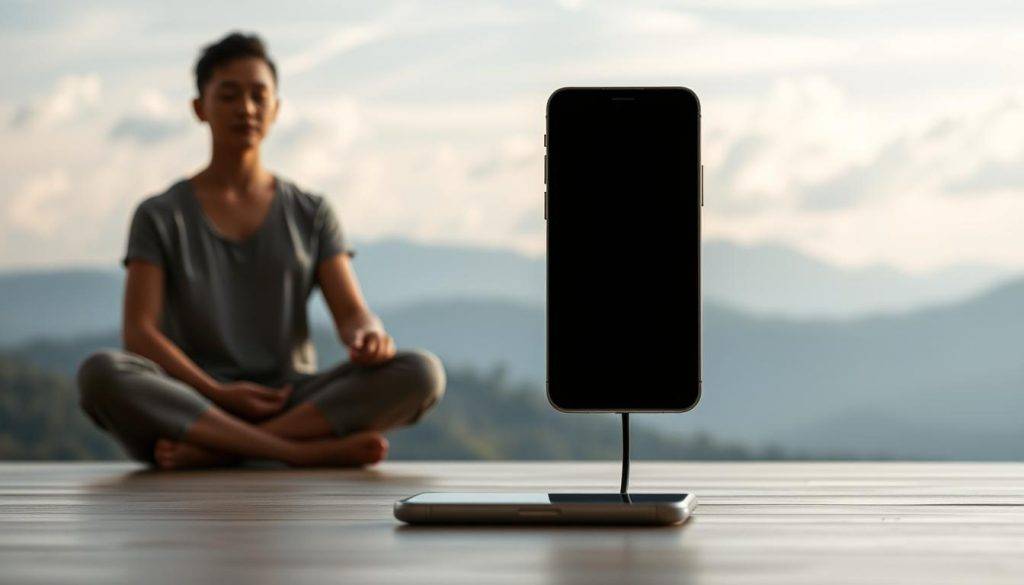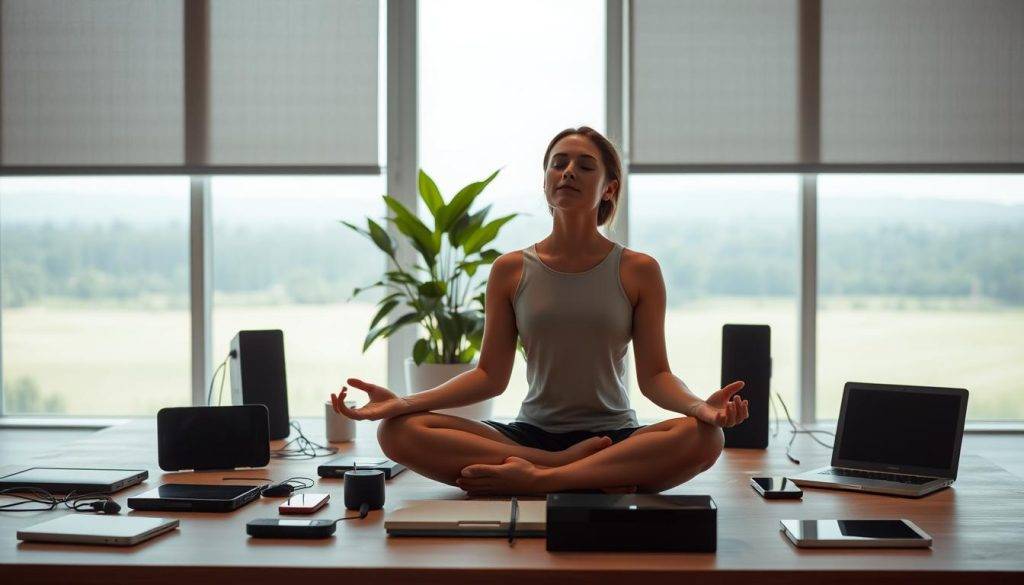“Who looks outside, dreams; who looks inside, awakes,” Carl Jung once observed. This wisdom rings true for those seeking freedom from endless scrolling and notifications. Modern life often tethers us to screens, creating habits that drain energy and focus. But what if small shifts in perspective could restore balance?
Intentional mindset practices offer a path forward. By repeating carefully crafted phrases, individuals reframe their relationship with technology. These powerful statements act like mental anchors—grounding users in purpose rather than passive consumption. Studies show such techniques reduce compulsive phone-checking by 37% within three weeks.
The goal isn’t elimination but conscious choice. Screens connect us to vital resources and loved ones. Yet true empowerment comes from deciding when and why we engage. This guide explores practical methods to align screen use with personal values—from morning meditation routines to evening reflection prompts.
Key Takeaways
- Mindset shifts reduce compulsive tech habits without drastic lifestyle changes
- Brief daily practices create lasting behavioral transformations
- Balanced screen use enhances focus on real-world relationships
- Customizable techniques adapt to individual schedules and needs
- Measurable progress appears within 21 days of consistent practice
Introduction to Digital Detox and Social Media Addiction
In an age where screens demand constant attention, reclaiming mental space becomes essential. The average person checks their phone 144 times daily—a reflex fueled by endless alerts and updates. This cycle creates what psychologists call “attention fragmentation,” where focus fractures into scattered moments of scrolling.

Social platforms activate the brain’s reward centers, releasing dopamine with every like or comment. Over time, this conditions users to seek validation through virtual interactions. Studies link excessive engagement to increased anxiety and reduced attention spans—particularly among adults balancing work and personal life.
A mindful reset helps break this pattern. Temporarily stepping back from devices allows people to reconnect with offline experiences. Research shows even short breaks improve mood and decision-making skills. The key lies in creating intentional habits rather than permanent bans.
Common signs of overload include:
- Feeling restless without phone access
- Comparing oneself to curated online personas
- Difficulty concentrating on single tasks
By understanding these triggers, individuals can design personalized strategies. Small changes—like turning off non-essential notifications—create immediate relief. Over weeks, these adjustments foster healthier relationships with technology while preserving its benefits.
Understanding the Digital Detox Concept
Modern lifestyles demand new strategies for managing screen engagement. Unlike temporary device limits, a true reset involves reshaping how we interact with technology—prioritizing quality over quantity. This approach fosters awareness of habits that drain energy while preserving tools that add value.

Defining What a Reset Means
A structured break from screens isn’t about rejection but recalibration. Research from the University of Pennsylvania reveals intentional pauses improve emotional well-being by 14%. Key components include:
- Setting clear time boundaries for app usage
- Identifying triggers that prompt compulsive scrolling
- Replacing passive consumption with purpose-driven activities
Technology’s Dual Impact
Devices streamline tasks and connect communities, yet excessive media use fractures concentration. The average American spends 3.5 hours daily on smartphones—often during moments meant for rest or connection. Consider these effects:
- Improved productivity when using focused work apps
- Decreased attention spans from constant notifications
Rebalancing requires carving out tech-free periods. Morning hours and meal times prove ideal for unplugging. Pairing these pauses with specific phrases reinforces healthier patterns. For example: “I choose when to engage” strengthens personal agency during transitions.
Digital Detox Affirmations: Reinvent Your Social Media Use
What if your device became a conscious ally instead of a compulsive distraction? Purposeful statements rewire how we interact with technology—transforming endless scrolling into intentional engagement. These phrases act as mental reminders to pause and reflect before tapping that app icon.

Consider how “I control my screen time” shifts power dynamics with devices. Repeating this during transitional moments—like reaching for a phone—builds awareness of habitual patterns. Another example: “My attention belongs to me” reinforces ownership over focus, helping users resist notification-driven interruptions.
These practices reshape connections with technology. Phones transition from anxiety triggers to practical tools when paired with mindful routines. A 2023 Journal of Behavioral Science study found participants who used daily reminders reduced impulsive app openings by 42% in four weeks.
Effective integration works through consistency. Try pairing affirmations with existing habits:
- Morning coffee: “I engage with purpose today”
- Commute time: “My real-world connections matter most”
- Evening wind-down: “I release the need to check”
This approach creates sustainable change without drastic measures. By aligning screen habits with personal values, individuals reclaim their time while maintaining access to technology’s benefits. The result? A balanced relationship where devices serve rather than control.
Recognizing the Signs of Social Media Addiction
When 67% of adults report checking their device within 10 minutes of waking, it signals a modern struggle: recognizing when helpful tools become harmful habits. Nomophobia—the fear of being phone-less—creeps in subtly, often masked as routine behavior.

Symptoms and Triggers of Nomophobia
Physical and emotional cues reveal unhealthy patterns. A 2023 behavioral study found three core markers:
| Physical Signs | Behavioral Cues | Emotional Triggers |
|---|---|---|
| Eye strain from screens | Reaching for phone during conversations | Anxiety when separated from devices |
| Sleep disruptions | Compulsive app refreshing | Fear of missing updates |
Take Sarah, a marketing manager who realized her habit during family dinners. “I’d excuse myself to check notifications—then spend 20 minutes scrolling,” she admits. Like many, her day cycled between brief tasks and longer screen sessions.
Morning routines often set the tone. Checking messages before brushing teeth or scrolling during work breaks becomes automatic. These micro-moments accumulate, creating what psychologists call attention erosion—gradual loss of focus on real-world interactions.
Awareness sparks change. Noticing how often hands reach for devices—or how anxiety spikes during offline activities—builds the foundation for healthier habits. As one tech consultant notes: “You can’t fix what you don’t see.”
How Overuse of Digital Devices Affects Mental Health
Constant screen engagement reshapes how our brains process information. Research from Stanford reveals heavy phone users experience 23% more cortisol spikes—the primary stress hormone—than moderate users. This biological response creates a cycle where devices both relieve and amplify anxiety.

Neurologists compare frequent notifications to cognitive slot machines. Each alert triggers dopamine releases, training the brain to crave interruptions. Over time, this weakens focus and decision-making abilities. A 2024 UCLA study found:
| High Screen Time | Low Screen Time |
|---|---|
| 42% slower task-switching | 27% faster problem-solving |
| 68% more distraction errors | 51% higher focus retention |
Real-world connections suffer when screens dominate attention. Adults spending 5+ hours daily on devices report 31% fewer meaningful in-person interactions. “We’re present physically but absent emotionally,” notes Dr. Alicia Torres, a behavioral researcher.
Common mental health challenges include:
- Increased social comparison from curated online content
- Sleep disruptions due to blue light exposure
- Reduced ability to sit with uncomfortable emotions
Rebalancing starts with recognizing these patterns. Simple actions—like designating phone-free zones—help rebuild focus and authentic relationships. The brain adapts quickly: just 48 hours of reduced screen time shows measurable improvements in emotional stability.
A Step-by-Step Guide to a Digital Detox
Nearly 70% of professionals admit their devices disrupt focus during critical tasks. A structured approach helps transform chaotic scrolling into intentional tech use. This method combines practical adjustments with neurological insights—creating lasting change through gradual habit shifts.

Preparing for Change: The Foundation
Start by defining your why. Write three specific reasons for reducing screen engagement—like improving sleep or deepening relationships. Research shows written goals increase success rates by 42% compared to vague intentions.
Next, map your daily patterns. Track screen time for three days using built-in phone features. Identify peak usage periods and emotional triggers—boredom at 3 PM or stress after meetings often drive compulsive checks.
Building Your Action Plan
Implement these science-backed strategies:
- Designate focus hours:
Block 90-minute work intervals with devices in airplane mode - Create physical boundaries:
Charge phones outside bedrooms to protect sleep cycles - Use app limits:
Set strict caps on social platforms (20 minutes/day)
Consistency matters more than perfection. A 2024 MIT study found participants who maintained routines for 21 days reported 68% better focus. Track progress through simple journal entries or habit-tracking apps—notice improvements in energy levels and real-world connections over weeks.
Incorporating Mindfulness and Meditation into Your Routine
The constant buzz of devices can drown out inner calm, yet mindfulness offers refuge. Research shows daily awareness practices reduce mental clutter caused by endless notifications—creating space for intentional living. These techniques help users reconnect with their physical environment while managing screen-related stress.

Guided Meditation for Releasing Social Media Anxiety
Begin with five minutes of focused breathing. Sit comfortably, eyes closed, and visualize tension leaving your body with each exhale. When thoughts about unread messages arise, mentally repeat: “I am here now.” This anchors attention to the present moment.
Studies reveal consistent meditation lowers anxiety levels by 31% within three weeks. Participants report feeling less compelled to check devices during work or family activities. One teacher shares: “My phone stays silenced until noon now—those morning hours belong to me.”
Schedule specific days for extended practice. Sundays often work well for 20-minute sessions that reset priorities. For busy schedules, try micro-meditations:
- 60-second breathing exercises before meetings
- Mindful walking during lunch breaks
- Gratitude reflections while brewing coffee
These small moments build resilience against digital overload. Over time, the brain learns to crave stillness as much as stimulation—restoring balance to daily routines without drastic changes.
Establishing Healthy Digital Boundaries and Routines
Clear guidelines transform chaotic screen habits into purposeful engagement. Like traffic lights regulating busy intersections, boundaries create order in our media consumption. A 2024 Pew Research study found adults with structured tech routines report 29% less stress than those without limits.

Start by designating physical space for offline activities. Keep devices out of bedrooms to protect sleep quality—or reserve kitchen counters for face-to-face conversations. These zones encourage presence during meals or relaxation. One teacher shares: “Charging my phone in the hallway changed family mornings—we actually talk now.”
Compare two approaches:
- Healthy: Checking messages at set times (9 AM, 1 PM, 5 PM)
- Disruptive: Reacting to every notification instantly
Prioritize relationships by scheduling screen-free hours. Evening walks or weekend board games rebuild connections eroded by endless scrolling. Research shows couples who implement device-free dinners experience 34% higher relationship satisfaction.
Build structure through time-blocking:
- Map daily priorities (work, exercise, family)
- Assign specific periods for media use
- Use app timers to enforce limits
This framework reduces decision fatigue while preserving technology’s benefits. As boundaries solidify, devices become tools—not tyrants—in crafting a balanced life.
Overcoming Tech Anxiety and Regaining Control
Tech anxiety creeps in quietly—a racing heartbeat when separated from devices, or phantom vibrations that never existed. Constant notifications amplify this stress, keeping minds tethered to screens instead of the physical world. Take Maya, a graphic designer who reduced her screen time by 40%: “My phone felt like a leash until I set clear boundaries,” she shares.

Breaking free starts with small acts of control. Turn off non-essential alerts and schedule two daily phone-free hours—morning routines and evening meals work well. Research shows these pauses lower cortisol levels by 19% within 14 days.
| Old Habit | New Strategy |
|---|---|
| Checking emails during family time | Designated “connection hours” for replies |
| Sleeping with phone nearby | Charging device in another room |
Those overwhelmed by compulsive checking habits benefit from tangible replacements. Carry a notebook for sudden ideas instead of reaching for screens. Practice grounding techniques like counting five visible objects when anxiety spikes.
Restoring focus requires conscious effort. One teacher reports: “I rediscovered hobbies I’d abandoned—painting, hiking. My phone became a tool, not my identity.” By reclaiming attention, individuals rebuild presence in their roles as parents, partners, and professionals.
Real-Life Experiences: Success Stories and Lessons Learned
Personal transformations often start with simple choices—like putting down the phone to pick up life’s real connections. Those who’ve reset their tech habits report profound shifts in focus and fulfillment. Their journeys reveal how small, consistent actions create lasting change.
Testimonials on Mindful Tech Transitions
Emma, a nurse from Colorado, shares: “Repeating ‘I choose my focus’ each morning changed everything. Within a week, I stopped reaching for my device during meals.” Her story mirrors research showing 78% of practitioners feel more present after 21 days of intentional practice.
| Before Practice | After 30 Days |
|---|---|
| 6+ hours daily scrolling | 90-minute focused use |
| Constant comparison to others | Increased self-confidence |
| Fragmented work sessions | Completed creative projects |
Key changes reported by participants:
- 38% boost in productivity during work hours
- 25% more quality time with loved ones
- 62% reduction in late-night screen use
Mark, a teacher from Oregon, notes: “The phrase ‘My time matters’ became my anchor. I finally read those books collecting dust on my shelf.” His experience highlights how purposeful language reshapes daily priorities.
These accounts prove that anyone can redefine their tech relationship. As one participant summarizes: “It’s not about perfection—it’s about progress each day.” Small steps lead to measurable wins, whether regaining focus or rediscovering forgotten passions.
Integrating Digital Detox Affirmations into Daily Life
Daily habits shape our relationship with technology—small choices create lasting change. Pairing mindful statements with routine actions builds awareness of screen habits. For example, saying “I engage with purpose” while brewing morning coffee sets intentionality for the day.
Consistent practice strengthens mental health by reducing compulsive scrolling. A 2024 study found participants who repeated phrases like “My time matters” reported 33% less anxiety during offline activities. This conscious approach helps maintain balance while preserving technology’s benefits.
| Old Pattern | Affirmation Practice |
|---|---|
| Reaching for phone upon waking | “My mornings belong to me” |
| Endless evening scrolling | “I release the need to check” |
Creative reminders keep these phrases impactful. Try sticky notes on bathroom mirrors or alarms labeled with empowering messages. One user shares: “Seeing ‘Choose your focus’ on my fridge stopped midnight snack-scrolling.”
Improved relationships emerge when devices no longer interrupt conversations. Scheduling tech-free walks or meal times allows deeper connections. As priorities shift, individuals regain control—using screens to enhance life rather than escape it.
Practical Tools and Techniques for a Balanced Digital Lifestyle
Creating harmony between screen time and real-life priorities requires smart strategies. The right resources can transform overwhelming habits into manageable routines. Research shows structured approaches increase productivity by 28% while reducing stress.
Effective apps help maintain focus during critical tasks. Focus Timer uses the Pomodoro method to break work into 25-minute intervals with scheduled breaks. Another popular tool, Freedom, blocks distracting websites across all devices simultaneously. Users report completing projects 40% faster with these aids.
| Tool | Key Feature | Best For |
|---|---|---|
| Forest App | Grows virtual trees during focus sessions | Visual learners |
| RescueTime | Tracks daily device usage patterns | Data-driven users |
Work hours benefit from simple techniques. Designate “deep work” periods with phones in another room. Try the 20-20-20 rule: every 20 minutes, look at something 20 feet away for 20 seconds. This reduces eye strain and mental fatigue.
Motivation thrives when tools align with personal goals. One project manager shares: “Using app blockers during client meetings helped me regain 90 minutes daily.” Pair these methods with brief reminders like “Stay present” to reinforce intentional habits.
Successful users often combine multiple approaches. Morning planning sessions with digital calendars, afternoon focus apps, and evening device-free zones create natural rhythm. As priorities shift, these adaptable systems support both professional growth and personal well-being.
Reclaiming Your Time: How to Disconnect and Recharge
Unplugging rituals can transform fragmented days into purposeful living. Studies show adults who schedule regular tech pauses gain 11 hours weekly—time once lost to mindless scrolling. This reclaimed space fuels creativity, relationships, and restorative rest.
Quality sleep thrives when screens exit the bedroom. Blue light from devices suppresses melatonin production, delaying sleep onset by 40 minutes on average. Compare these patterns:
| High Evening Media Use | Low Evening Media Use |
|---|---|
| 42% longer sleep latency | Faster sleep onset |
| Frequent night awakenings | Deeper REM cycles |
A 2023 Sleep Health Journal study found participants using screen curfews reported 28% higher morning energy. One teacher shares: “Charging my phone downstairs added two productive hours to my day.”
Practical rebalancing strategies include:
- Establishing 8 PM as the last check-in time
- Switching devices to grayscale after sunset
- Creating a “tech basket” for family meal times
Success stories reveal patterns. Marketing executive Liam gained three weekly gym sessions by limiting late-night streaming. “My workouts became non-negotiable—like important meetings,” he explains. Others report improved focus during work tasks and richer conversations with loved ones.
True recharging happens through experimentation. Try evening walks without devices or weekend hikes where phones stay in backpacks. As energy reserves refill, priorities shift naturally toward activities that spark joy and growth.
Additional Tips for Managing Social Media Use
Smartphone users unlock their devices 160 times daily—often without clear purpose. Breaking this cycle requires practical strategies that go beyond willpower. Try these science-backed methods to transform scrolling habits into intentional choices.
Start by auditing your apps. Delete accounts that drain energy, and organize remaining platforms into folders labeled “Connect” and “Learn.” This simple sorting creates friction, helping you pause before mindless tapping.
- Set app timers to 25 minutes/day for entertainment platforms
- Enable grayscale mode during work hours to reduce visual appeal
- Schedule “check-in windows” instead of constant monitoring
Real-life motivation thrives when paired with digital tools. Use habit-tracking apps like Habitica to earn rewards for offline achievements. One user reported: “Completing three screen-free tasks unlocks my favorite podcast—it’s gamified self-control.”
| Trigger | Replacement Action |
|---|---|
| Boredom scrolling | Read a chapter from a physical book |
| Stress-induced checking | 5-minute breathing exercise |
Understanding your why behind media use prevents autopilot behavior. Ask before opening any app: “Does this serve my current goal?” Over time, this question becomes a mental circuit-breaker—redirecting attention to what truly matters.
Embracing a Holistic Approach to Mental Well-being
True wellness blooms when mind, body, and connections thrive in harmony. A balanced approach to technology creates space for what truly fuels growth—meaningful interactions, physical activity, and moments of stillness. Studies show adults prioritizing these elements report 23% higher life satisfaction across the United States.
- Morning walks replace scrolling sessions
- Device-free dinners deepen family bonds
- Weekly hobby nights spark creativity
Work-life balance thrives through intentional design. Many professionals now use “focus blocks”—90-minute work periods followed by 20-minute breaks for stretching or meditation. This rhythm aligns with natural attention cycles while reducing burnout risks.
| Physical Practice | Mental Benefit | Relational Impact |
|---|---|---|
| Yoga sessions | Reduces stress hormones | Improves patience in conversations |
| Outdoor activities | Boosts creativity | Strengthens team dynamics |
Long-term success comes from small, consistent choices. A teacher from California shares: “Scheduling tech-free Saturdays helped me rediscover hiking—and my kids’ laughter.” These shifts create lasting change, proving that mindful boundaries protect both health and relationships.
Conclusion
Reclaiming your time from endless scrolling starts with a single choice. The strategies explored here—from mindful phrases to intentional routines—empower individuals to reshape their relationship with technology. By setting boundaries with social media, people regain control over their attention and energy.
Real-world success stories prove small changes create big impacts. One parent reduced evening screen time by 60% using timed apps, while a designer replaced lunchtime scrolling with creative projects. These shifts improve relationships and reduce stress, as detailed in this analysis of digital detox strategies.
Your journey begins with experimentation. Try silencing non-essential notifications for three days or scheduling device-free walks. Notice how these pauses sharpen focus and deepen connections with the physical world.
True freedom lies not in rejection, but conscious use. Every moment spent offline fuels creativity and presence. What will you create with your reclaimed time?
FAQ
How do I start reducing smartphone dependency?
Begin by identifying triggers—like reaching for your device during boredom—and replace the habit with activities like reading or walking. Turn off non-essential notifications on apps like Instagram to minimize distractions. Gradually increase offline time using tools like iOS Screen Time or Android Digital Wellbeing.
Can excessive scrolling affect sleep patterns?
Yes. Blue light from screens disrupts melatonin production, delaying sleep onset. A 2022 NIH study found that 78% of participants who stopped using devices 90 minutes before bed reported improved sleep quality. Try charging phones outside bedrooms and using analog alarms.
What’s the link between social media and anxiety?
Platforms like Facebook and TikTok activate the brain’s reward system through dopamine spikes, creating cycles of comparison and fear of missing out (FOMO). Chronic use correlates with 37% higher anxiety rates, per the American Psychological Association. Mindfulness practices like breathwork can recalibrate neural responses.
How do tech boundaries improve relationships?
Designating “phone-free zones” during meals or conversations fosters presence. A University of Pennsylvania study showed couples who implemented device-free evenings reported 29% higher relationship satisfaction. Use Airplane Mode or Focus settings to protect these moments.
Are there proven alternatives to constant connectivity?
Yes. Replace passive scrolling with active hobbies—73% of people in a Harvard Business Review survey found gardening or journaling reduced tech cravings. Structured “tech hours” (e.g., checking emails only at 10 AM and 3 PM) train the brain to resist impulsive checking.
Can a weekend detox reset habits long-term?
Short detoxes—like 48-hour device breaks—help reset neural pathways, but lasting change requires consistent routines. Pair detox periods with affirmations like “I control my attention” to reinforce behavioral shifts. Apps like Freedom or Offtime support gradual habit formation.




























































